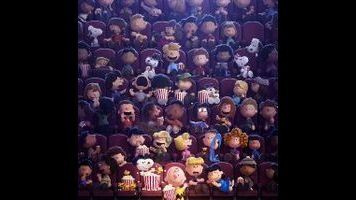
The Peanuts Movie opens with a scene not dissimilar from the beginning of A Boy Named Charlie Brown, the feature that first brought Charles Schulz’s Peanuts comic strip to the big screen back in 1969. In both movies, Charlie Brown sets out to fly a kite and fails; the chief difference is that in The Peanuts Movie, perhaps trying to mimic the appeal of the beloved Charlie Brown Christmas special, he’s flying his kite during the winter months. That’s the Peanuts adaptation challenge in a nutshell: There is both a wealth of material to pull from (baseball, football, camp, the Great Pumpkin, uncomfortable crushes, Snoopy’s fantasies), and the difficulty of picking and choosing which bits of lore to assemble into a larger narrative—especially considering how much has already been strip-mined by movies, specials, a stage musical, and the endlessly cycled strips themselves. Every new adaptation is the softest of reboots.
That’s true of The Peanuts Movie, too, despite an upgrade in animation. Blue Sky, the studio behind almost no good feature cartoons (including various Ice Ages and Rios), visualizes a script co-written by Schultz’s son and grandson in the bright hues of contemporary computer animation, with the faintest additions of 3-D textures. The kids’ faces do look more spherical, but not distractingly so, and the animators take care to render their facial expressions in Schulz-style lines rather than uncanny detail. While it’s more technically elaborate treatment than the characters have ever received, it’s also gentler and more eye-pleasing than any of Blue Sky’s other features. It‘s also a neat extension of Schulz’s style—though, granted, no one needs to see Pig-Pen’s permanent cloud of filth rendered more vividly.
The higher production values pay off during a running series of fantasy sequences where Snoopy imagines himself fighting the Red Baron, as he is wont to do. Though his imagination cooks up enemy planes and an imaginary love interest dog called Fifi (inexplicably non-voiced by Kristin Chenoweth, opposite archival material from the late Bill Melendez as both Snoopy and Woodstock), the World War I Flying Ace’s own plane remains, as ever, his red doghouse. The play-pretend combat, cleverly yoked to another familiar Snoopy routine from the comics, finally lives up to the dog’s dreams while drawing slapstick curlicues around the film’s margins. It’s the best aerial dogfight involving actual dogs since Up.
The big Snoopy sequences aren’t especially vital to the movie’s nominal plot, which, like the old Peanuts movies, is not exactly tightly wound. But The Peanuts Movie does a better job linking together its episodes than many of the older films, structuring itself around a series of mild school events: a standardized test, a talent show, a dance contest, and a book report. They’re all occasions for Charlie Brown to attempt to prove his worth to the new girl in class, the unnamed Little Red-Haired Girl. This version of Charlie Brown is a touch generic—a bumbling, good-hearted dreamer without the richer, more philosophical veins of melancholy that run through some of Schulz’s best work.
That simplification is reflected in the new movie’s attempt to honor the tradition of casting actual children as the characters’ voices. (This sounds obvious enough, but stars ranging from Rihanna to Taylor Swift have masqueraded as tweens in recent animation.) Past Peanuts specials and movies used children that didn’t sound particularly studied or actor-y, and while this holds true in some of the Peanuts Movie casting—Linus (Alexander Garfin) and Lucy (Hadley Belle Miller) are particularly spot-on—young Noah Schnapp (the young son of Tom Hanks in Bridge Of Spies) gives Charlie Brown a more polished vocal. He speaks more clearly, but with a somewhat reduced vocabulary. Still, the movie does provide him with some hilariously Schulz-ish worries: When partnered with a girl for a school assignment, he frets about whether he’s ready for a relationship that might turn into a house, a mortgage, and escrow.
Even without dialogue operating at peak sophistication levels, this charming movie mostly captures the tone of Schulz’s work and the voices of his characters. Lucy lobs insults disguised as psychiatric help, Linus offers levelheaded advice, and when Charlie Brown achieves local notoriety, his little sister Sally leads tours of the Brown home and sells souvenirs, lightly kidding the strip’s history as a merchandising bonanza. Most of its flinches at Schulz’s bleakness are minor—little moments where the movie wants to assure its young audience that the kids onscreen aren’t that sad or upset. That includes the sweet but not especially Schulz-like ending; the filmmakers can’t find a way out of their story that doesn’t, to some degree, give in to narrative demands for validation. (In their defense, the more bittersweet ending of A Boy Named Charlie Brown, probably the best possible balance of big defeats and little victories, is already taken). Doubtless some hardcore Peanuts fans will shudder. But this movie hasn’t been made exclusively for adult nostalgists, and is something of a gift for its newest, youngest potential fans. A bigger-budget Peanuts is still far more idiosyncratic than almost anything they’ll see at a movie theater this year.